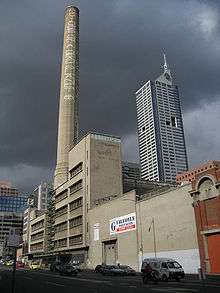Spencer Street Power Station
| Spencer Street Power Station | |
|---|---|
 The power station undergoing demolition in 2007 | |
| Country | Victoria, Australia |
| Location | Spencer Street, Melbourne, |
| Coordinates | 37°48′53″S 144°57′12″E / 37.81472°S 144.95333°ECoordinates: 37°48′53″S 144°57′12″E / 37.81472°S 144.95333°E |
| Status | Closed & Demolished |
| Commission date | 1892[1] |
| Decommission date | 1982 |
| Thermal power station | |
| Primary fuel | coal, oil |
Spencer Street Power Station was a Victorian era coal and (later) oil-fired power station which operated on Spencer Street in central Melbourne, Victoria, Australia. Opened in 1892, it was closed in 1982 after becoming redundant. Eventually deemed an eyesore, demolition commenced in 2006.
History
Spencer Street Power Station was built by the City of Melbourne to supply electricity to the city.[2] Arthur James Arnot designed and managed Spencer Street power station from 1894-1901 for the Melbourne City council.[3][4]
A Station:- The first power plant consisted of 24 General Electric direct current (DC) generators installed in four groups of six. Each group was belt driven by a 300HP Austral Otis horizontal compound slow speed steam engine. The terminal voltage was 3 kV DC and the electricity was used for street lights, trams, lifts and city buildings. Steam was supplied from four Babcock & Wilcox water tube boilers. In 1897 four General Electric 75KW alternators were added. They were belt driven by the existing engines. Output was 2 kV and 72 Hz. In 1900 a Peach three-crank compound 2500HP steam engine was installed. It was coupled to a Johnson & Phillips 120KW alternator. The alternating current (AC) was used in the surrounding suburbs via transformers. 1905 saw further expansion with one 200KW alternator, 4x350KW vertical Belliss steam engines that were direct-coupled to DC generators at 460V DC. This was to augment the city supply. Steam was supplied by another four Babcock boilers.[5]
In 1907 the first turbines were installed, with two 750KW British Westinghouse Parsons 4.4 kV single-phase machines added. The old arc lighting plant was removed to provide the space. 1908 saw three Allen triple-expansion engines installed, each coupled to 750KW generator and more boilers. A Siemens 4.4MW 6.6 kV three-phase alternator was added in 1913. Next year, two William Robinson 5MW turbo-alternators were added. 1917 saw the further addition of a 6.5MW turbo-alternator from British Westinghouse. This was a three-phase, 6.6 kV 50HZ machine, and ran at 1500RPM. In 1927 four 6MW three-phase 6.6 kV turbo-alternators were installed. At this time all the DC generators were replaced with motor-generators generators.[6] By 1923 there were a total of 20 Babcock water tube boilers, each having a steam capacity of 17,000 lb/hr at 165PSI and 520degF. Smoke was directed into two smoke stacks each 175 feet high.
B+C Stations:- In 1949 two 15MW Parsons turbo-generators were installed in an adjacent site. Steam was supplied by large oil-fired water tube boilers. Ten years later two 30MW Parsons machines were added and called C station. Steam was supplied by more water-tube boilers that were fitted with pulverized fuel equipment for burning coal, but for pollution reasons they were only oil fired.
In 1941 the station came under the management of the State Electricity Commission of Victoria and became part of the state electricity network.[7] Progressive upgrades saw the capacity of the station rise to 109 MW by the 1960s, but newer power stations in the Latrobe Valley meant that the station was retained for peak use only.
Abandonment and demolition
After closure in 1982, the power station sat idle awaiting redevelopment. In 2003 a man was arrested for painting the slogan 'No jobs on a dead planet' on the chimney.[8] A girl died in 2004 after falling down a seven-metre hole inside the power station.[9]
In May 2006 the site was sold for $7.6 million to Russian developers Vladimir Stepanov, Dmitri Bril and Oleg Mogilnitskiy, with asbestos removal and demolition commencing soon after to allow the redevelopment of the site.[10] The historic tower started being dismantled in September 2007 and the site was fully cleared in April 2008.[11]
Gallery
 Demolition in October 2007
Demolition in October 2007 Demolition in March 2006
Demolition in March 2006
Notes
- ↑ "MELBOURNE ELECTRIC SUPPLY.". The Argus (Melbourne, Vic. : 1848 - 1956). Melbourne, Vic.: National Library of Australia. 3 February 1923. p. 10. Retrieved 5 December 2012.
- ↑ "ENGINEERING.". The Argus (Melbourne, Vic. : 1848 - 1956). Melbourne, Vic.: National Library of Australia. 30 March 1916. p. 4. Retrieved 5 December 2012.
- ↑ Biography - Arthur James Arnot - Australian Dictionary of Biography
- ↑ "How Electricity Came to Melbourne.". The Argus (Melbourne, Vic. : 1848 - 1956). Melbourne, Vic.: National Library of Australia. 16 October 1934. p. 37. Retrieved 5 December 2012.
- ↑ One Hundred Years of Engineering;Electricity Supply in Victoria; E.Bate Bsc AIME
- ↑ Early Electric Supply in Melbourne;Miles Pierce
- ↑ "CITY POWER STATION.". The Argus (Melbourne, Vic. : 1848 - 1956). Melbourne, Vic.: National Library of Australia. 2 April 1941. p. 4. Retrieved 5 December 2012.
- ↑ "Protester gets high on his message". The Age. 2003-09-05.
- ↑ "Girl dies after fall at power station". The Age. 2004-10-23.
- ↑ "Council nod to power station removal". The Age. 2006-09-16.
- ↑ "Historic Spencer Street chimney dismantled". News Online. Australian Broadcasting Corporation. 2007-09-06.
Bibliography
- Edwards, Cecil (1969). Brown Power. A jubilee history of the SECV. State Electricity Commission of Victoria.